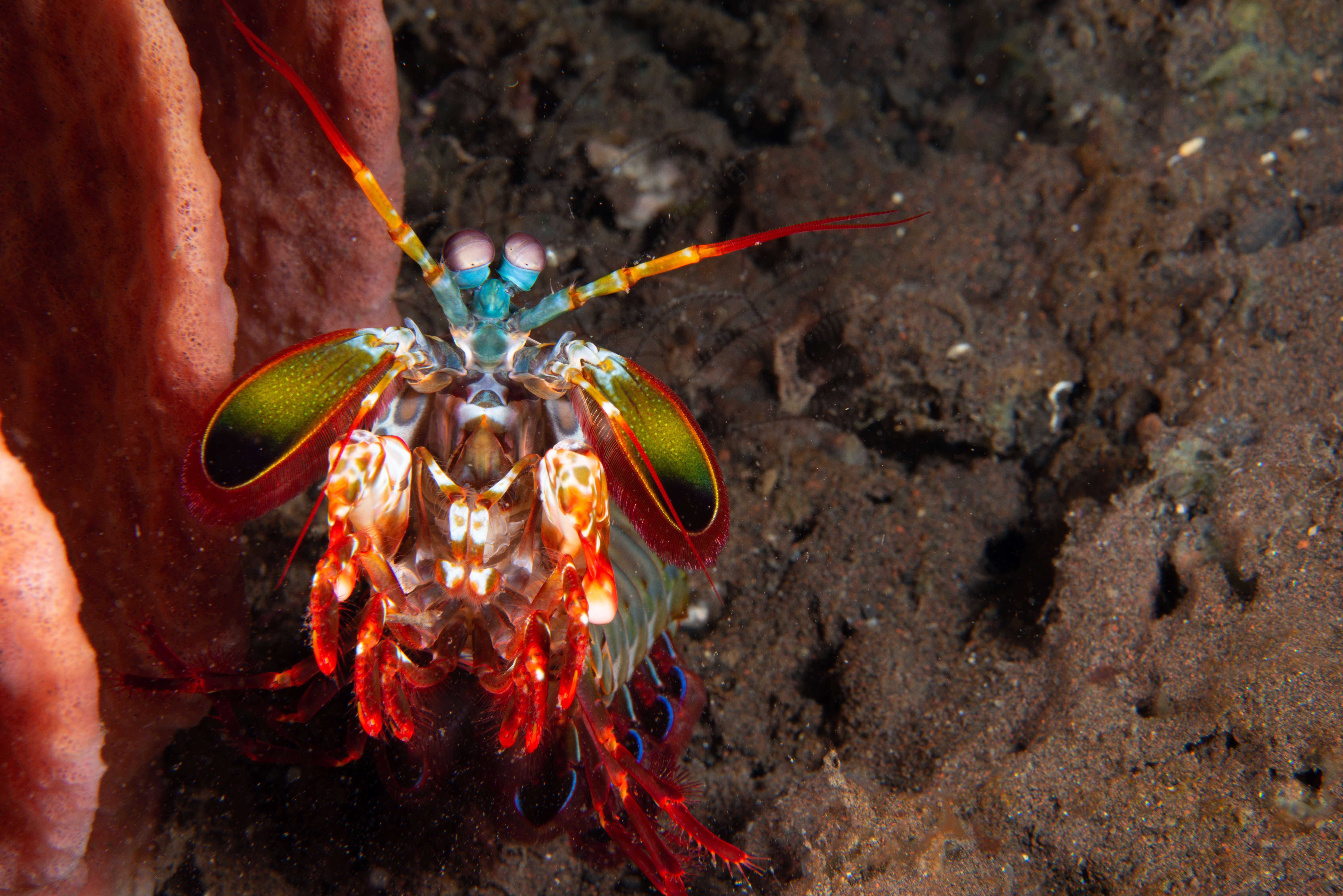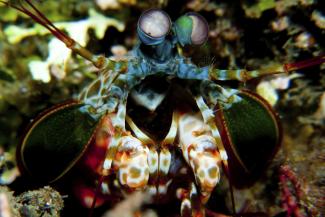
Distribution:
Tropical and subtropical waters of the
Indian and Pacific Oceans
Ecosystem:
Marine habitats like coral reefs, rocky
substrates, and sandy/mud bottoms
Feeding Habits:
Carnivorous Predator
Taxonomy:
Family Stomatopods
Class Malacostraca
Overview and Physical Characteristics
The mantis shrimp (order Stomatopoda) is so named because of its blend of features: the front part of its body has the bulging eyes and grasping forelimbs resembling a praying mantis, while its latter half has the hard exoskeleton resembling a shrimp.
This seemingly odd combination of physical features has been a quite a successful one—the fossil record for Stomatopoda dates to 400 million years. A carnivorous crustacean, the mantis shrimp is a formidable hunter, using its keen eyesight and powerful forelegs to subdue its prey.
Feeding Habits and Predation
Mantis shrimp engage in two styles of hunting: spearing, or smashing, depending on the type of forelimbs they possess. Spearing mantis shrimp have several sharp barbs at the end of their forelimbs, used to impale fish, shrimp, or any other soft-bodied prey. Smashing mantis shrimp have an incredibly powerful calcified “elbow” on their appendages, and a blow from this elbow is used to stun and break the shells of snails, crabs, and clams, so they can feed on their soft bodies inside.
Although they are near the top of the food chain, Stomatopoda does have its own predators. Sharks, octopuses, and tuna are among the creatures who will eat mantis shrimp if given the opportunity.
Habits and Distribution
There are well over 500 species of mantis shrimp, which primarily live in the tropical and subtropical waters of the Indian and Pacific Ocean between eastern Africa and Hawaii, although a few other species also inhabit the waters of Cape Cod to the Gulf of America, as well as off the coast of Brazil and in the Mediterranean.
Mantis shrimp tend to live in burrows in rocks, sand, or coral, only leaving their burrow to get prey or find a mate. They favor different locations for burrowing depending on whether they are the smashing or spearing species. The spearing species prefer soft sediment for their burrows, while the smashing species use coral or other hard substrata for their habitat. When they do leave their burrow, Stomatopoda are highly aggressive, engaging with other inhabitants of their biome, often in a fight for territory.
Behavior and Reproduction
For such an aggressive creature it’s no surprise that most mantis shrimp live alone, with the males and females coming together briefly only to mate. A few mantis shrimp species mate for life, sharing a burrow for 15- to-20- year span. Courtship begins when the male Stomatopoda performs an elaborate dance to catch the eye of a female, who, if she is interested, will join in the dance. If all goes well, they will retire to their burrow, where they engage in the final stage of courtship, mating belly to belly.
The male deposits sperm into a special pouch just inside the opening to the female’s reproductive organs, and eggs are fertilized inside her body as they are being laid. Eggs are laid in batches, taking anywhere from 10 days to two months to hatch. Mantis shrimp hatchlings go through several distinct stages of development before reaching adulthood in about three months.
Visual System and Communication
Mantis shrimp have one of the most complex visual systems of any creature – 16 photoreceptors that can detect UV, and polarized light, which humans cannot see. For comparison, human eyes have three photoreceptors for combinations of red, green and blue, while many birds have four photoreceptors for ultraviolet (UV) as well as red, green, and blue.
Scientists have theorized that forms of polarized light are used as a secret communication system between mantis shrimp in courtship as well as in fighting.
Fun Fact
The force of the impact of mantis shrimp’s smashing appendage is comparable to that of a small-caliber bullet.
For More Information
- Peacock Mantis Shrimp (Odontodactylus scyllarus) from the National Aquarium
- Peacock Mantis Shrimp from Oceana
- Peacock Mantis Shrimp from the Georgia Aquarium
- Peacock Mantis Shrimp from National Geographic Kids
- The Mantis Shrimp from the Chesapeake Bay Program
This story is part of the “Unleashing the Science” series, showcasing how bureaus within the Department of the Interior produce and apply science to ensure responsible management decisions for our planet now and for the future.
--BOEM--
The Department of the Interior’s Bureau of Ocean Energy Management (BOEM) manages development of U.S. Outer Continental Shelf (OCS) energy, mineral, and geological resources in an environmentally and economically responsible way.



